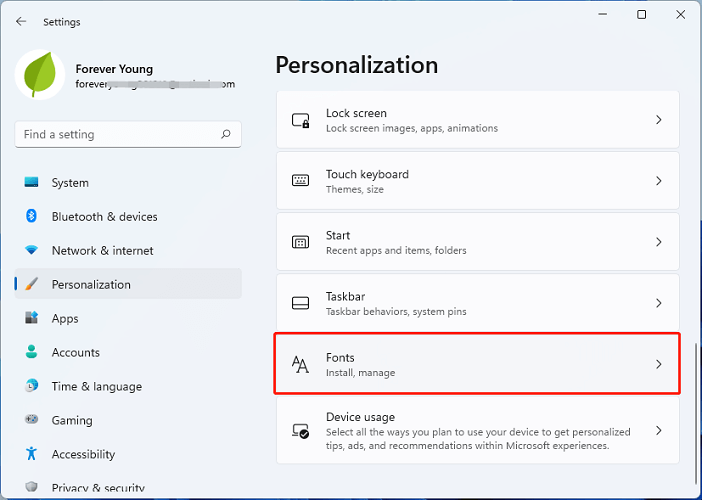
Introduction:
In the intricate tapestry of Windows customization, the default font plays a significant role in shaping the visual identity of your digital environment. While Microsoft provides a set of standard fonts, the allure of personalization beckons users to explore the vast realm of typography. In this comprehensive guide, we embark on a journey of aesthetic refinement and individual expression as we unravel the steps, tools, and nuances involved in changing the default Windows font. By the end of this exploration, you’ll possess the skills to tailor your digital canvas, turning the mundane into a personalized masterpiece.
Understanding the Impact of Fonts:
- Visual Identity: Fonts define the visual identity of your Windows interface. Whether sleek and modern or classic and timeless, the choice of font contributes to the overall aesthetics of your digital experience.
- Readability and Accessibility: The right font enhances readability and accessibility, ensuring that text is clear and legible. Customizing the default font allows you to prioritize both style and functionality.
Embarking on the Font Customization Journey: A Step-by-Step Guide:
- Backup Your System: Before making any changes, it’s crucial to create a backup of your system. This ensures that you can revert to the original settings if needed. Use built-in Windows tools or third-party backup solutions for added security.
- Choose Your Desired Font: Select a font that aligns with your aesthetic preferences. You can explore free font repositories online or use fonts you’ve downloaded and installed on your system. Fonts come in various styles, including serif, sans-serif, script, and more.
- Install the Chosen Font: Once you’ve chosen a font, install it on your system. Right-click on the font file and select “Install” from the context menu. Alternatively, you can copy the font file to the Fonts folder in the Control Panel.
- Access Windows Settings: Open the Windows Settings by clicking on the Start Menu and selecting the gear-shaped Settings icon. Alternatively, press
Windows key + Ito access Settings directly. - Navigate to Personalization: Within the Settings window, navigate to “Personalization.” Here, you’ll find various customization options for your Windows interface.
- Choose Fonts: In the Personalization menu, select “Fonts” from the left-hand sidebar. This opens the Fonts settings, where you can customize different text elements on your system.
- Change the Default Font: Scroll down to find the “Change default font” section. Click on the drop-down menu next to “Font” and choose the installed font you want to set as the default. You can also adjust the font size to your liking.
- Apply and Save Changes: After selecting the desired font and adjusting settings, click on the “Apply” button to preview the changes. If you’re satisfied with the appearance, click “Save” to make the changes permanent.
Advanced Font Customization Tips:
- Registry Editor Tweaks: Advanced users can delve into the Registry Editor to fine-tune font settings further. Navigate to
HKEY_LOCAL_MACHINE\SOFTWARE\Microsoft\Windows NT\CurrentVersion\Fontsand modify font values. Exercise caution when editing the registry to avoid unintended consequences. - Customizing Individual Elements: While the default font change applies to various system elements, you can customize individual elements like icons, title bars, and menus by exploring additional customization settings in the Fonts section.
- Third-Party Tools: Consider using third-party tools that offer more extensive font customization options. Tools like “System Font Changer” allow users to change system fonts beyond the limitations of the built-in settings.
Common Challenges and Solutions:
- Compatibility Issues: Some fonts may not be compatible with certain Windows elements, leading to display issues. Test fonts thoroughly and be prepared to switch to a different font if compatibility problems arise.
- System Performance Impact: Extensive font customization can impact system performance, especially on older or less powerful hardware. Monitor your system’s performance after changing fonts and consider reverting to default if performance issues arise.
Practical Applications and Benefits:
- Branding and Personalization: Changing the default Windows font allows for personalization and branding, creating a unique visual identity that reflects your style and preferences.
- Improved Readability: Choosing a font that enhances readability can contribute to a more comfortable and enjoyable computing experience. Consider fonts with clear letterforms for optimal readability.
- Tailoring the User Interface: Font customization enables users to tailor the Windows interface to suit their tastes. Whether you prefer a sleek modern look or a more classic feel, the choice of font contributes significantly to the overall aesthetic.
Conclusion:
In the realm of Windows customization, changing the default font is a transformative journey that blends artistic expression with functional refinement. As you navigate the settings and explore font options, remember that the choices you make contribute to the digital ambiance you inhabit daily. Personalization is about more than aesthetics; it’s about creating an environment that resonates with your unique style and preferences. So, venture into the world of fonts, experiment with different styles, and sculpt a digital canvas that reflects the essence of you.